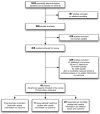Decision-model estimation of the age-specific disability weight for schistosomiasis japonica: a systematic review of the literature
- PMID: 18320018
- PMCID: PMC2254314
- DOI: 10.1371/journal.pntd.0000158
Decision-model estimation of the age-specific disability weight for schistosomiasis japonica: a systematic review of the literature
Abstract
Schistosomiasis is among the most prevalent parasitic infections worldwide. However, current Global Burden of Disease (GBD) disability-adjusted life year estimates indicate that its population-level impact is negligible. Recent studies suggest that GBD methodologies may significantly underestimate the burden of parasitic diseases, including schistosomiasis. Furthermore, strain-specific disability weights have not been established for schistosomiasis, and the magnitude of human disease burden due to Schistosoma japonicum remains controversial. We used a decision model to quantify an alternative disability weight estimate of the burden of human disease due to S. japonicum. We reviewed S. japonicum morbidity data, and constructed decision trees for all infected persons and two age-specific strata, <15 years (y) and > or =15 y. We conducted stochastic and probabilistic sensitivity analyses for each model. Infection with S. japonicum was associated with an average disability weight of 0.132, with age-specific disability weights of 0.098 (<15 y) and 0.186 (> or =15 y). Re-estimated disability weights were seven to 46 times greater than current GBD measures; no simulations produced disability weight estimates lower than 0.009. Nutritional morbidities had the greatest contribution to the S. japonicum disability weight in the <15 y model, whereas major organ pathologies were the most critical variables in the older age group. GBD disability weights for schistosomiasis urgently need to be revised, and species-specific disability weights should be established. Even a marginal increase in current estimates would result in a substantial rise in the estimated global burden of schistosomiasis, and have considerable implications for public health prioritization and resource allocation for schistosomiasis research, monitoring, and control.
Conflict of interest statement
The authors have declared that no competing interests exist.
Figures




Comment in
-
Schistosomiasis Japonica: The DALYs Recaptured.PLoS Negl Trop Dis. 2008 Mar 5;2(3):e203. doi: 10.1371/journal.pntd.0000203. PLoS Negl Trop Dis. 2008. PMID: 18320017 Free PMC article. No abstract available.
References
-
- Steinmann P, Keiser J, Bos R, Tanner M, Utzinger J. Schistosomiasis and water resources development: systematic review, meta-analysis, and estimates of people at risk. Lancet Infect Dis. 2006;6:411–425. - PubMed
-
- Lammie PJ, Fenwick A, Utzinger J. A blueprint for success: integration of neglected tropical disease control programmes. Trends Parasitol. 2006;22:313–321. - PubMed
-
- WHO. Geneve: World Health Organization; 2002. The World Health Report 2002: Reducing risk, promoting healthy life.
Publication types
MeSH terms
Grants and funding
LinkOut - more resources
Full Text Sources

